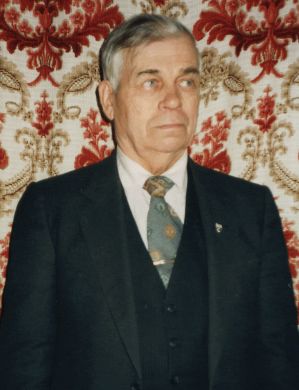Participant in the OUN underground and the Norilsk Uprising, persecuted after his release.
From a peasant family. Under Poland, he completed 6 grades. During the German occupation, he was forcibly taken to Lviv, where young men were taught trades before being sent to Germany. In May 1942, he escaped from that school to his aunt’s in Berezhany. There, he joined the OUN underground. On the orders of his leaders, he collected weapons and procured food.
In 1943, he was taken to Austria and joined the OUN. He received Ukrainian newspapers from Berlin and Vienna and conducted propaganda work. In 1945, he tried to join a UPA unit to cross into the American zone but was captured by Soviet forces. He went through a filtration camp and was forcibly mobilized into the Soviet Army. In April–May, he participated in combat against individual Wehrmacht groups in Austria. For a whole month, the new recruits were marched on foot from Austria through Hungary and Romania; in the city of Cluj-Napoca, they were put on narrow-gauge railway cars. Near Odesa, they were transferred to freight cars and transported for another month to Manchuria.
By then, the Kwantung Army had already surrendered. The same freight cars were loaded with Japanese prisoners of war, and the 162nd Mobile Transport Company, in which A. served, escorted them and then guarded them in Irkutsk. The company was later transferred to the Chelyabinsk Oblast in the Urals, and subsequently built a road to China. Failure to meet quotas was punished: they were not allowed to return to the barracks for the night.
Based on a denunciation by a soldier who had also been mobilized in Austria, A. was arrested on February 3, 1948. His winter clothing was taken away and he was issued summer clothes—he froze in a cold punishment cell in the military unit until his trial. On April 14, 1948, a “troika” sentenced A. to 25 years and 10 years of imprisonment, respectively, on charges of “treason against the homeland” during his time in Austria (Article 58-1 of the Criminal Code of the RSFSR) and “anti-Soviet agitation” (Article 58-10).
He worked in a stone quarry in Chelyabinsk. In the fall of 1948, he was sent to Krasnoyarsk, and from there, the prisoners were transported by barges pulled by a steamboat for two weeks to Dudinka. They died of dysentery: only about half arrived. In Norilsk, A. was sent to Gorlag No. 4—a “state special-regime camp.” They chiseled through the permafrost, laying the foundation for the “Medstroy” plant. A. worked there as a bricklayer almost until his release.
In 1950, P. SARANCHUK—A.’s cousin and peer—arrived at Gorlag. He spent about four months with him. On June 4, 1953, the Norilsk Uprising began and lasted until August 4. The main events unfolded in the neighboring, third hard-labor camp.
On August 12, 1955, a special commission from Krasnoyarsk reviewed A.’s case and released him “on parole.” People from Western Ukraine were forbidden to return to their native region, except to eastern or southern Ukraine.
A. went to a friend in Apostolove Raion, Dnipropetrovsk Oblast, and then got a job at the “Yuzhdomnaremont” plant. He received his passport and transferred to work as a bricklayer at a technical college, living in a student dormitory. A year later, on August 24, 1956, he married a girl named Halia, who was also an Ostarbeiter. In 1959, their daughter Olia was born. They received a room in a dormitory where there was one kitchen for the entire floor. In 1958, they bought half of a dilapidated hut, hoping to build a home with their own hands.
In 1959, A. enrolled in the evening department of a construction technical college. After work, he would go to the college, and only late at night, by lamplight, would he build their home. He made sure to have receipts for all building materials. However, in 1959, the prosecutor’s office opened a criminal case against A. under Article 199 of the Criminal Code of the Ukrainian SSR, “Unauthorized Seizure of Land and Unauthorized Construction.” Neighbors came to the trial and testified that the couple did not use anyone else’s labor. The court sentenced him to six months of correctional labor with a 25% deduction from his earnings and confiscation of the building. After the trial, A. asked the judge: “What kind of confiscation? This is an unfinished building. Is it mine now or not? What should I do with it?” The judge said: “Keep building just as you have been.” Within 4-5 years, A. completed the construction.
In total, A. worked for 8 years at the technical college, 8 years in the market administration, from 1967 at the medical equipment plant, and then for 19 years as a foreman in a repair and construction office. He retired in 1986.
In 1991, A. was rehabilitated for his 1948 conviction. In 1989, he joined the NRU (People’s Movement of Ukraine), and in 1992, he headed the regional organization of the Congress of Ukrainian Nationalists (KUN). In 1993, he participated in the creation of the regional Society of Political Prisoners and the Repressed and the OUN-UPA Brotherhood of Sicheslavshchyna, which he led until his death. He was buried on December 24, 2012, in Dnipropetrovsk.
Bibliography:
Interview with S. Andrushkiv, April 3, 2001: https://museum.khpg.org/1207219203.
International Biographical Dictionary of Dissidents in Central and Eastern Europe and the Former Soviet Union. Vol. 1. Ukraine. Part 1. – Kharkiv: Kharkiv Human Rights Protection Group; “Prava Liudyny.” – 2006. – pp. 1–516; Part 3. – pp. 517–1020; Part 3. – 2011. – pp. 1021–1380; Andrushkiv S.: pp. 1037-1038: https://museum.khpg.org/1314891527.
Vasyl Ovsiienko, Kharkiv Human Rights Protection Group.
Characters 4,950. Last read on May 13, 2016.

ANDRUSHKIV STEPAN SEMENOVYCH